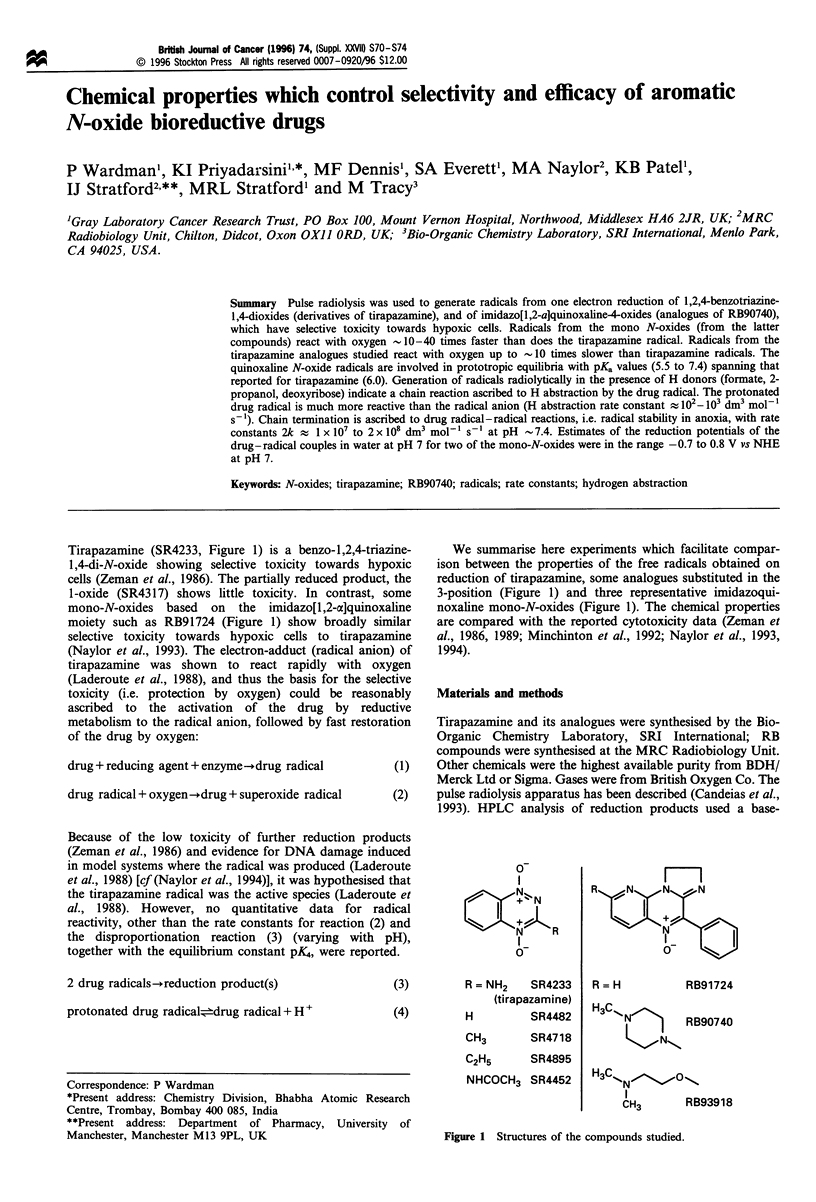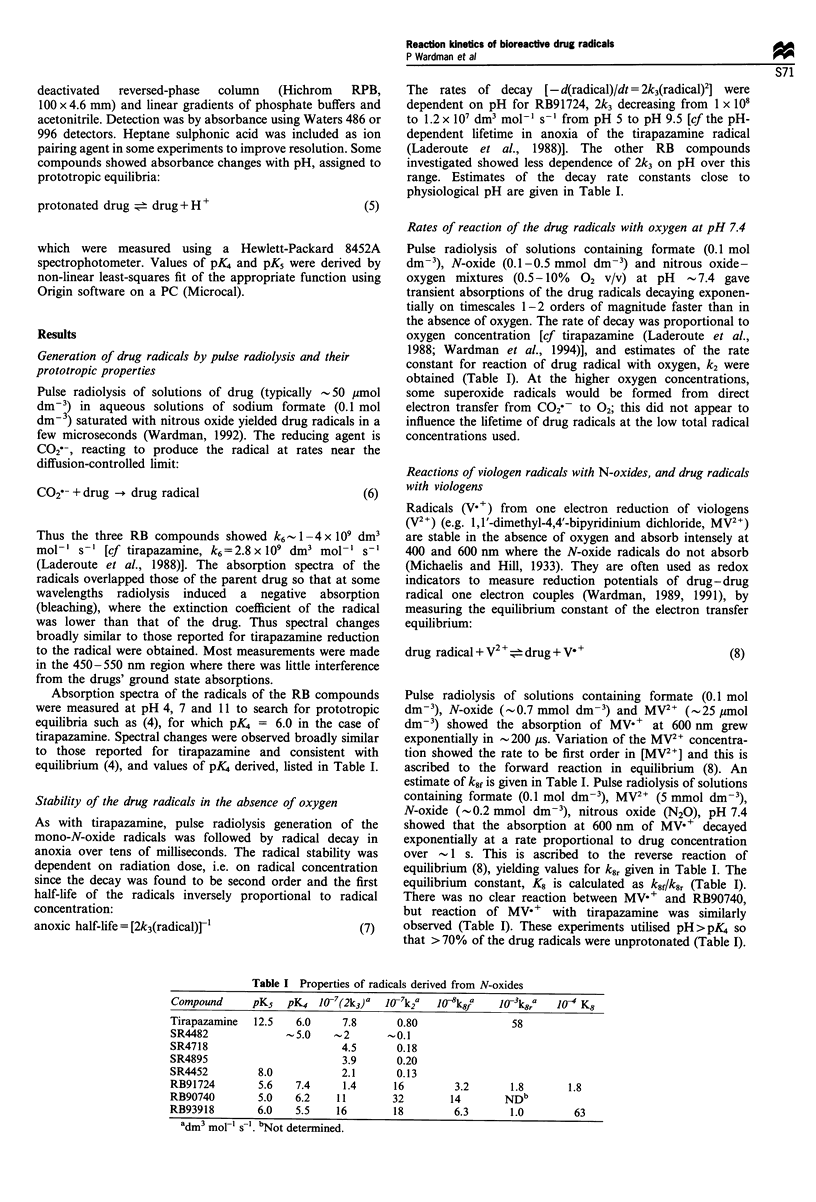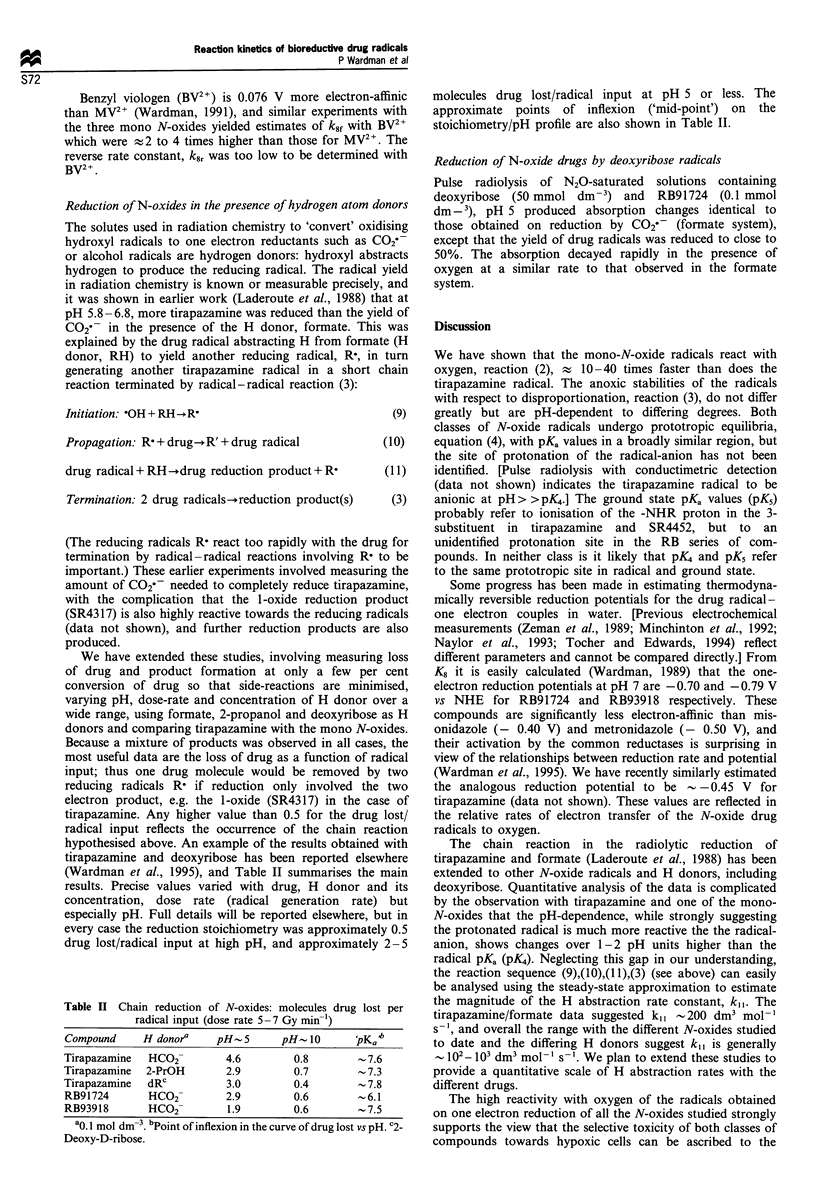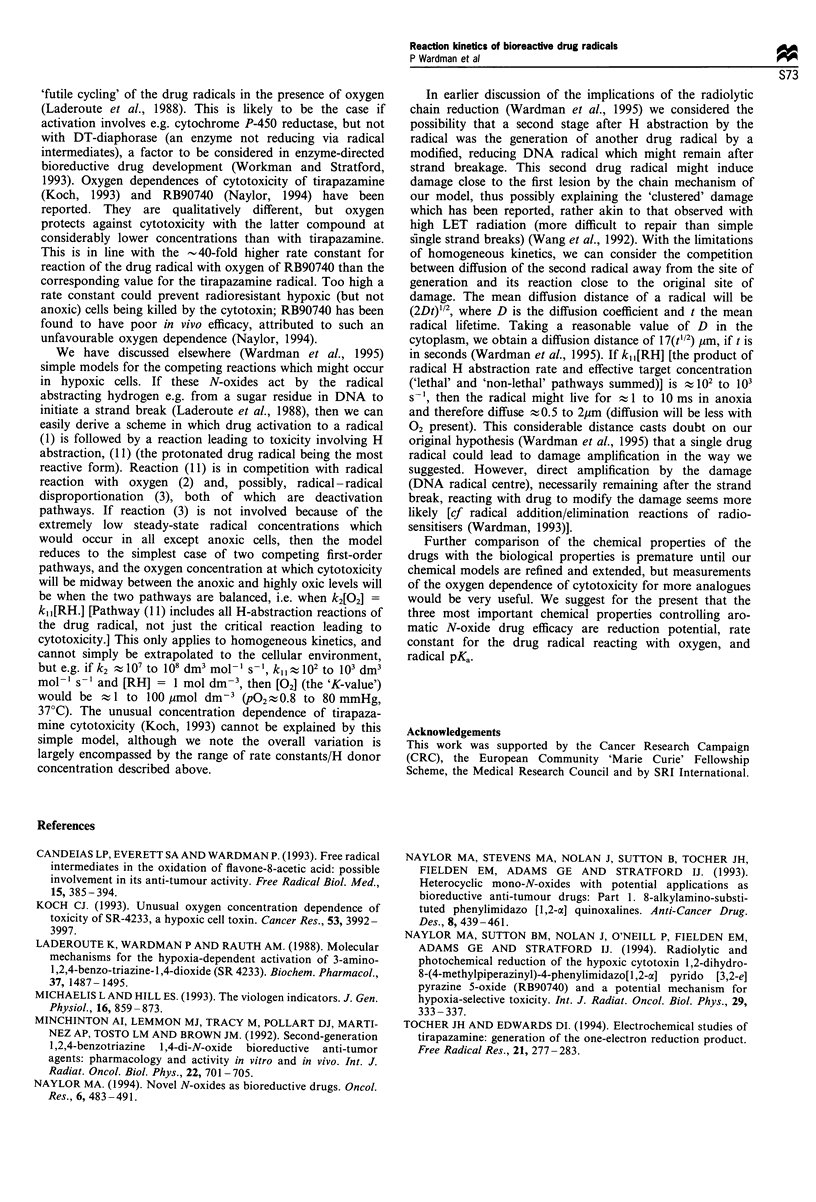Abstract
Pulse radiolysis was used to generate radicals from one electron reduction of 1,2,4-benzotriazine-1,4-dioxides (derivatives of tirapazamine), and of imidazo [1,2-a]quinoxaline-4-oxides (analogues of RB90740), which have selective toxicity towards hypoxic cells. Radicals from the mono N-oxides (from the latter compounds) react with oxygen approximately 10-40 times faster than does the tirapazamine radical. Radicals from the tirapazamine analogues studied react with oxygen up to approximately 10 times slower than tirapazamine radicals. The quinoxaline N-oxide radicals are involved in prototropic equilibria with pK(a) values (5.5 to 7.4) spanning that reported for tirapazamine (6.0). Generation of radicals radiolytically in the presence of H donors (formate, 2-propanol, deoxyribose) indicate a chain reaction ascribed to H abstraction by the drug radical. The protonated drug radical is much more reactive than the radical anion (H abstraction rate constant approximately equal to 10(2) - 10(3) dm3 mol-1 s-1). Chain termination is ascribed to drug radical-radical reactions, i.e. radical stability in anoxia, with rate constants 2k approximately equal to 1 x 10(7) to 2 x 10(8) dm3 mol-1 s-1 at pH approximately 7.4. Estimates of the reduction potentials of the drug-radical couples in water at pH 7 for two of the mono-N-oxides were in the range-0.7 to 0.8 V vs NHE at pH 7.
Full text
PDF




Selected References
These references are in PubMed. This may not be the complete list of references from this article.
- Candeias L. P., Everett S. A., Wardman P. Free radical intermediates in the oxidation of flavone-8-acetic acid: possible involvement in its antitumour activity. Free Radic Biol Med. 1993 Oct;15(4):385–394. doi: 10.1016/0891-5849(93)90038-v. [DOI] [PubMed] [Google Scholar]
- Koch C. J. Unusual oxygen concentration dependence of toxicity of SR-4233, a hypoxic cell toxin. Cancer Res. 1993 Sep 1;53(17):3992–3997. [PubMed] [Google Scholar]
- Laderoute K., Wardman P., Rauth A. M. Molecular mechanisms for the hypoxia-dependent activation of 3-amino-1,2,4-benzotriazine-1,4-dioxide (SR 4233). Biochem Pharmacol. 1988 Apr 15;37(8):1487–1495. doi: 10.1016/0006-2952(88)90010-x. [DOI] [PubMed] [Google Scholar]
- Minchinton A. I., Lemmon M. J., Tracy M., Pollart D. J., Martinez A. P., Tosto L. M., Brown J. M. Second-generation 1,2,4-benzotriazine 1,4-di-N-oxide bioreductive anti-tumor agents: pharmacology and activity in vitro and in vivo. Int J Radiat Oncol Biol Phys. 1992;22(4):701–705. doi: 10.1016/0360-3016(92)90507-e. [DOI] [PubMed] [Google Scholar]
- Naylor M. A. Novel N-oxides as bioreductive drugs. Oncol Res. 1994;6(10-11):483–491. [PubMed] [Google Scholar]
- Naylor M. A., Stephens M. A., Nolan J., Sutton B., Tocher J. H., Fielden E. M., Adams G. E., Stratford I. J. Heterocyclic mono-N-oxides with potential applications as bioreductive anti-tumour drugs: Part 1. 8-Alkylamino-substituted phenylimidazo [1,2-a] quinoxalines. Anticancer Drug Des. 1993 Dec;8(6):439–461. [PubMed] [Google Scholar]
- Naylor M. A., Sutton B. M., Nolan J., O'Neill P., Fielden E. M., Adams G. E., Stratford I. J. Radiolytic and photochemical reduction of the hypoxic cytotoxin 1,2-dihydro-8-(4-methylpiperazinyl)-4-phenylimidazo [1,2-a] pyrido [3,2-e] pyrazine 5-oxide (RB90740) and a potential mechanism for hypoxia-selective toxicity. Int J Radiat Oncol Biol Phys. 1994 May 15;29(2):333–337. doi: 10.1016/0360-3016(94)90285-2. [DOI] [PubMed] [Google Scholar]
- Tocher J. H., Edwards D. I. Electrochemical studies of tirapazamine: generation of the one-electron reduction product. Free Radic Res. 1994 Oct;21(5):277–283. doi: 10.3109/10715769409056580. [DOI] [PubMed] [Google Scholar]
- Wang J., Biedermann K. A., Brown J. M. Repair of DNA and chromosome breaks in cells exposed to SR 4233 under hypoxia or to ionizing radiation. Cancer Res. 1992 Aug 15;52(16):4473–4477. [PubMed] [Google Scholar]
- Wardman P., Candeias L. P., Everett S. A., Tracy M. Radiation chemistry applied to drug design. Int J Radiat Biol. 1994 Jan;65(1):35–41. doi: 10.1080/09553009414550051. [DOI] [PubMed] [Google Scholar]
- Wardman P. Pulse radiolysis and drug design. BJR Suppl. 1992;24:6–10. [PubMed] [Google Scholar]
- Wardman P. The reduction potential of benzyl viologen: an important reference compound for oxidant/radical redox couples. Free Radic Res Commun. 1991;14(1):57–67. doi: 10.3109/10715769109088942. [DOI] [PubMed] [Google Scholar]
- Workman P., Stratford I. J. The experimental development of bioreductive drugs and their role in cancer therapy. Cancer Metastasis Rev. 1993 Jun;12(2):73–82. doi: 10.1007/BF00689802. [DOI] [PubMed] [Google Scholar]
- Zeman E. M., Baker M. A., Lemmon M. J., Pearson C. I., Adams J. A., Brown J. M., Lee W. W., Tracy M. Structure-activity relationships for benzotriazine di-N-oxides. Int J Radiat Oncol Biol Phys. 1989 Apr;16(4):977–981. doi: 10.1016/0360-3016(89)90899-7. [DOI] [PubMed] [Google Scholar]
- Zeman E. M., Brown J. M., Lemmon M. J., Hirst V. K., Lee W. W. SR-4233: a new bioreductive agent with high selective toxicity for hypoxic mammalian cells. Int J Radiat Oncol Biol Phys. 1986 Jul;12(7):1239–1242. doi: 10.1016/0360-3016(86)90267-1. [DOI] [PubMed] [Google Scholar]


